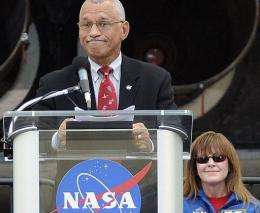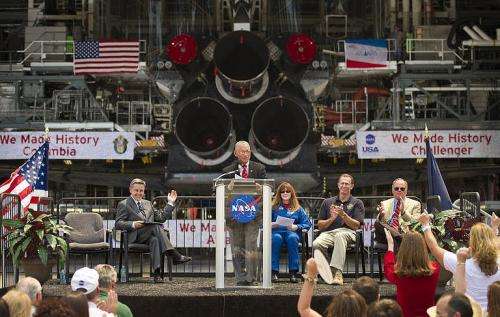Relations between the United States and its partners in space remain strong, despite tighter budgets and concerns about costs and delays in building the space station, NASA chief Charles Bolden, pictured in April 2011, said on Friday.
Relations between the United States and its partners in space remain strong, despite tighter budgets and concerns about costs and delays in building the space station, NASA chief Charles Bolden said on Friday.
"We're talking about having vision and looking to the future, but planning that future in a very constrained fiscal environment," Bolden said in an interview on a tour to meet with European counterparts.
"I wouldn't say we're scaling back the dreams, what we're doing is that we are descoping, or at least discussing ways to descope, some of the missions that we've been planning for a number of years to fit within tighter budgetary constraints."
Bolden explained that "descoping" entailed scrutinising joint projects to pare back some costs but without affecting their key goals.
He gave the example of talks last month in which a joint US-European mission to Mars involving two landers examined options of having only one lander and reducing the instrument payload.
The NASA administrator met in Paris with the heads of the European Space Agency (ESA) and France's National Centre of Space Research (CNES). He heads to Italy next week for talks with Italian space agency chiefs.
The trip takes place when the US space shuttle is about to be phased out after helping to complete the International Space Station (ISS), a giant erector-set project troubled by cost blowouts and delays.
The United States has borne the lion's share, but indirect costs have also hit the Europeans and reduced the scope of scientific research aboard the orbital outpost.
That has sparked some grumbling about the point of the ISS and doubts whether Europe should join the US in future "prestige" projects such as a return to the Moon and, perhaps by 2030, explore Mars.
Bolden argued that the US partnership with ESA, Canada, Japan and Russia not only remained strong, it also had been fortified.
NASA Administrator Charles Bolden announces where four space shuttle orbiters will be permanently displayed at the conclusion of the Space Shuttle Program during an event held at Kennedy Space Center in April 2011. Relations between the United States and its partners in space remain strong, despite tighter budgets and concerns about costs and delays in building the space station, NASA chief said.
"The International Space Station has made everybody more willing to team up with America and the other partner nations," he said.
"Over the past 10 years we've seen what we can do in spite of the naysayers, in spite of all kinds of challenges. We have an operating space station that has been permanently occupied for a little bit more than 10 years now, has a full-time crew of six, always has an international crew onboard rather than any one nation, and is being serviced by more than four nations right now."
In recent weeks, the ISS has been visited by ESA's robot freighter, Japan's HTV spacecraft, Russia's Soyuz and Progress and the shuttle Endeavour.
Endeavour's sister, Atlantis, is set to launch to the ISS on July 8, the final mission in the 30-year shuttle programme. Bolden himself flew four times, twice as commander.
The reusable orbiter programme was driven by hopes of ushering in an era of simple, low-cost space travel.
But it turned out to be complex and massively expensive, requiring careful maintenance to address safety issues that led to the loss of two out of the five-shuttle fleet.
Phaseout means the United States will be without its own manned space capability for the first time in half a century.
Until a likely rocket-and-capsule alternative, provided this time by the private sector, becomes available, US astronauts will depend on getting into space aboard Russia's veteran Soyuz.
Bolden played down the significance of this, saying the United States had had experience of a similar gap after the loss of the shuttle Columbia in 2003.
"Almost all the companies tell us that they can have the capability available within three years after being awarded a contract. So we're talking about 2014, 2015 timeframe, which is about three years, a little bit more than three years from now," he said.
(c) 2011 AFP























